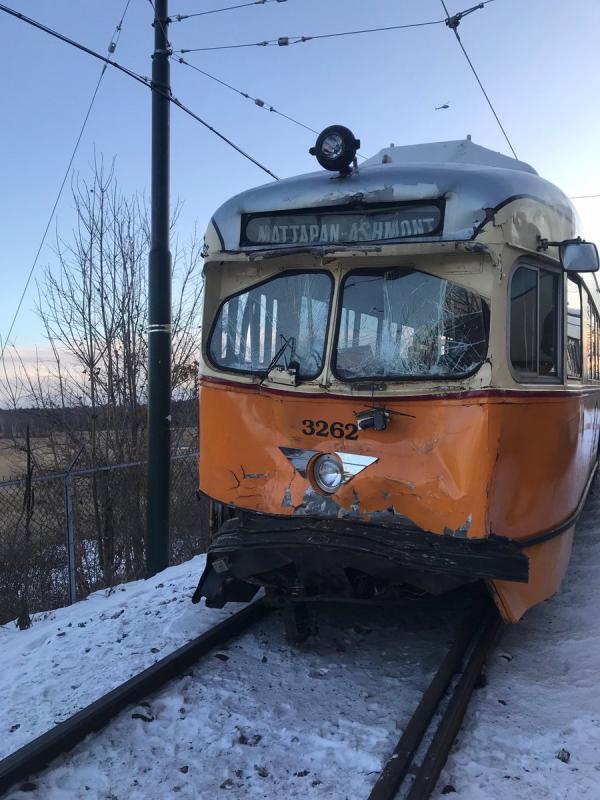January 17, 2018

One of the trolleys involved in a Dec. 29 collision that injured 18 people and significantly damaged two trains. Boston Fire photo
The fate of the Mattapan High-Speed Trolley, a locally beloved offshoot of the Red Line serviced by 1940s-era cars, is the subject of renewed discussion after a collision last month took two trolleys out of circulation.
With several months of winter ahead, T officials and commuters alike are awaiting the results of a full MBTA study on the line in the coming weeks.
Already struggling with the two trolleys out of commission and in need of “long-term repair work,” the line faced a further setback on Dec. 29 when an inbound train heading to Ashmont between the Cedar Grove and Butler stations rear-ended the train in front of it, resulting in 18 minor injuries, Jeffrey Gonneville, the T’s deputy general manager, told the Fiscal and Management Control Board at their Jan. 8 meeting.
Both Presidents' Conference Committee (PCC) cars sustained “significant structural damage,” according to MBTA spokesman Joe Pesaturo.
The operator of the train stated that he was distracted by a disabled vehicle on the outbound track, Gonneville said, “and was looking and watching what was going on there as he was moving forward and just did not expect to have a stopped vehicle in front of him.”
Though operator error does seem to be the cause of the collision, Gonneville said, there will be procedural changes made as the investigation progresses.
But the impact has already been felt. “Due to the age and, frankly, the damage that has occurred, we are two short of these Mattapan trolleys,” Gonneville said.
Two trolleys at the Mattapan car house are “in relatively good condition with the exception of the propulsion equipment on the trains,” Gonneville added, noting that the MBTA’s mechanical team is evaluating the possibility of using a combination of parts from the those two cars and the two involved in the crash to produce “at least two functioning trolley cars,” Pesaturo said in an email on Tuesday.
That would bring what is normally a 10-car fleet to seven functioning trains. Peak service time is slightly behind schedule with the loss, running four trolleys on a cycle instead of the usual five, officials said, with arrivals starting at every 6.5 minutes rather than 5 minutes.
Pesaturo said the T could, and would, operate five trolley cars for service with the new operational cars brought back online.
The trolleys are at the mercy of inclement weather, MBTA officials note. On the day of the board meeting, Gonneville said that three of the four operational trolleys were temporarily out of commission for reasons involving snow or other issues.
And there lies the paradox of the trolley: its historic and aesthetic appeal comes from its 1940s origins, the same thing that makes the trams vulnerable to inhospitable weather conditions and aging and unavailable parts.
In a letter sent to MassDOT in March 2016 advocating for what was ultimately $7.9 million to be dedicated to keeping the current fleet operational and in good condition, state Rep. Dan Cullinane and other local elected officials asked that trolleys continue to be the service vehicles along the line.
In times of construction, particularly brutal weather, or disrupted service, the PCC cars are replaced by MBTA shuttle buses that trace the trolleys’ paths, albeit on a less scenic route, along its eight-station schedule between Ashmont and Mattapan.
This was to be the case this week on Wednesday. In the face of a possible half-foot of snow overnight Tuesday, MBTA officials announced that shuttle buses would transport riders starting Wednesday morning. Anything beyond four inches of snow on the trolley tracks makes operations risky.
The Mattapan trolley is a selling point for transportation-oriented development projects along the line. A proposal to redevelop the Mattapan MBTA station parking lot into a 135-unit mixed-use development would be bounded by the trolley line, the new Neponset Greenway — which includes a dramatic canopy walk across the trolley tracks — and River Street.
According to peak hour MBTA measures cited in the Mattapan Station development’s city filings, the trolley is consistently among the most frequent transit options for those around Mattapan Square, arriving at the station every 5 to 12 minutes.
“With 4,586 daily riders, the [Mattapan High-Speed Line] serves as a vital transportation link for the residents of Boston’s southern neighborhoods,” the developers Preservation of Affordable Housing and the Nuestra Comunidad Development Corporation wrote. Their project is expected to generate another 204 daily transit trips.
The MBTA is evaluating the reliability of the existing line and considering potential routes that may involve innovative maintenance of the existing trolleys, replica trolleys, or even a much-maligned dedicated bus lane along the tracks. This study is expected to conclude “within weeks,” said Pesaturo.
“If this current fleet is not able to meet the current reliability and dependability that we expect, new trolleys made to look like the ones we have now could be a solution to make all sides happy,” Cullinane said in a phone call on Tuesday.
“I think that the big thing here is we want the information," he said of the study. "People want to look at the information to see what the realities are and what the possibilities are.”
Villages:


